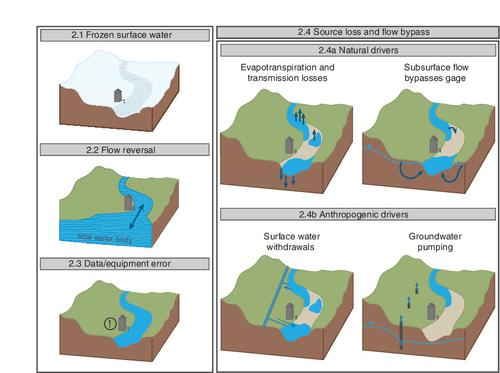当前位置:
X-MOL 学术
›
WIREs Water
›
论文详情
Our official English website, www.x-mol.net, welcomes your
feedback! (Note: you will need to create a separate account there.)
Zero or not? Causes and consequences of zero-flow stream gage readings.
WIREs Water ( IF 6.8 ) Pub Date : 2020-04-13 , DOI: 10.1002/wat2.1436 Margaret A Zimmer 1 , Kendra E Kaiser 2 , Joanna R Blaszczak 3 , Samuel C Zipper 4 , John C Hammond 5 , Ken M Fritz 6 , Katie H Costigan 7 , Jacob Hosen 8 , Sarah E Godsey 9 , George H Allen 10 , Stephanie Kampf 11 , Ryan M Burrows 12 , Corey A Krabbenhoft 13 , Walter Dodds 14 , Rebecca Hale 15 , Julian D Olden 16 , Margaret Shanafield 17 , Amanda G DelVecchia 18 , Adam S Ward 19 , Meryl C Mims 20 , Thibault Datry 21 , Michael T Bogan 22 , Kate S Boersma 23 , Michelle H Busch 24 , C Nathan Jones 25 , Amy J Burgin 26 , Daniel C Allen 24
WIREs Water ( IF 6.8 ) Pub Date : 2020-04-13 , DOI: 10.1002/wat2.1436 Margaret A Zimmer 1 , Kendra E Kaiser 2 , Joanna R Blaszczak 3 , Samuel C Zipper 4 , John C Hammond 5 , Ken M Fritz 6 , Katie H Costigan 7 , Jacob Hosen 8 , Sarah E Godsey 9 , George H Allen 10 , Stephanie Kampf 11 , Ryan M Burrows 12 , Corey A Krabbenhoft 13 , Walter Dodds 14 , Rebecca Hale 15 , Julian D Olden 16 , Margaret Shanafield 17 , Amanda G DelVecchia 18 , Adam S Ward 19 , Meryl C Mims 20 , Thibault Datry 21 , Michael T Bogan 22 , Kate S Boersma 23 , Michelle H Busch 24 , C Nathan Jones 25 , Amy J Burgin 26 , Daniel C Allen 24
Affiliation

|
Streamflow observations can be used to understand, predict, and contextualize hydrologic, ecological, and biogeochemical processes and conditions in streams. Stream gages are point measurements along rivers where streamflow is measured, and are often used to infer upstream watershed‐scale processes. When stream gages read zero, this may indicate that the stream has dried at this location; however, zero‐flow readings can also be caused by a wide range of other factors. Our ability to identify whether or not a zero‐flow gage reading indicates a dry fluvial system has far reaching environmental implications. Incorrect identification and interpretation by the data user can lead to inaccurate hydrologic, ecological, and/or biogeochemical predictions from models and analyses. Here, we describe several causes of zero‐flow gage readings: frozen surface water, flow reversals, instrument error, and natural or human‐driven upstream source losses or bypass flow. For these examples, we discuss the implications of zero‐flow interpretations. We also highlight additional methods for determining flow presence, including direct observations, statistical methods, and hydrologic models, which can be applied to interpret causes of zero‐flow gage readings and implications for reach‐ and watershed‐scale dynamics. Such efforts are necessary to improve our ability to understand and predict surface flow activation, cessation, and connectivity across river networks. Developing this integrated understanding of the wide range of possible meanings of zero‐flows will only attain greater importance in a more variable and changing hydrologic climate.
中文翻译:

零还是零?零流量流量表读数的原因和后果。
流量观测可用于了解,预测和关联河流中的水文,生态和生物地球化学过程和条件。流量表是沿河测量流量的点测量方法,通常用于推断上游流域规模的过程。当液位计读数为零时,这可能表明液位已在该位置干燥。但是,零流量读数也可能是由多种其他因素引起的。我们能够识别零流量表读数是否表明干河流系统具有深远的环境影响。数据用户的不正确识别和解释可能导致模型和分析中的水文,生态和/或生物地球化学预测不准确。在这里,我们描述零流量表读数的几种原因:冻结的地表水,流量逆转,仪器错误以及自然或人为驱动的上游水源损失或旁通流量。对于这些示例,我们讨论了零流量解释的含义。我们还将重点介绍确定流量存在的其他方法,包括直接观测,统计方法和水文模型,这些方法可用于解释零流量表读数的原因以及对水位和分水岭尺度动力学的影响。这些努力对于提高我们理解和预测河流网络中地表水活化,停止和连通性的能力是必要的。对零流量的广泛可能含义的这种综合理解只会在水文气候变化多变的情况下变得更加重要。自然或人为驱动的上游源损失或旁路流量。对于这些示例,我们讨论了零流量解释的含义。我们还将重点介绍确定流量存在的其他方法,包括直接观测,统计方法和水文模型,这些方法可用于解释零流量表读数的原因以及对水位和分水岭尺度动力学的影响。这些努力对于提高我们理解和预测河流网络中地表水活化,停止和连通性的能力是必要的。对零流量的广泛可能含义的这种综合理解只会在水文气候变化多变的情况下变得更加重要。自然或人为驱动的上游源损失或旁路流量。对于这些示例,我们讨论了零流量解释的含义。我们还将重点介绍确定流量存在的其他方法,包括直接观测,统计方法和水文模型,这些方法可用于解释零流量表读数的原因以及对水位和分水岭尺度动态的影响。这些努力对于提高我们理解和预测河流网络中地表水活化,停止和连通性的能力是必要的。对零流量的广泛可能含义的这种综合理解只会在水文气候变化多变的情况下变得更加重要。我们讨论零流量解释的含义。我们还将重点介绍确定流量存在的其他方法,包括直接观测,统计方法和水文模型,这些方法可用于解释零流量表读数的原因以及对水位和分水岭尺度动力学的影响。这些努力对于提高我们理解和预测河流网络中地表水活化,停止和连通性的能力是必要的。对零流量的广泛可能含义的这种综合理解只会在水文气候变化多变的情况下变得更加重要。我们讨论零流量解释的含义。我们还将重点介绍确定流量存在的其他方法,包括直接观测,统计方法和水文模型,这些方法可用于解释零流量表读数的原因以及对水位和分水岭尺度动力学的影响。这些努力对于提高我们理解和预测河流网络中地表水活化,停止和连通性的能力是必要的。对零流量的广泛可能含义的这种综合理解只会在水文气候变化多变的情况下变得更加重要。可将其用于解释零流量表读数的原因以及对范围和分水岭尺度动力学的影响。这些努力对于提高我们理解和预测河流网络中地表水活化,停止和连通性的能力是必要的。对零流量的广泛可能含义的这种综合理解只会在水文气候变化多变的情况下变得更加重要。可将其用于解释零流量表读数的原因以及对范围和分水岭尺度动力学的影响。这些努力对于提高我们理解和预测河流网络中地表水活化,停止和连通性的能力是必要的。对零流量的广泛可能含义的这种综合理解只会在水文气候变化多变的情况下变得更加重要。
更新日期:2020-04-13
中文翻译:

零还是零?零流量流量表读数的原因和后果。
流量观测可用于了解,预测和关联河流中的水文,生态和生物地球化学过程和条件。流量表是沿河测量流量的点测量方法,通常用于推断上游流域规模的过程。当液位计读数为零时,这可能表明液位已在该位置干燥。但是,零流量读数也可能是由多种其他因素引起的。我们能够识别零流量表读数是否表明干河流系统具有深远的环境影响。数据用户的不正确识别和解释可能导致模型和分析中的水文,生态和/或生物地球化学预测不准确。在这里,我们描述零流量表读数的几种原因:冻结的地表水,流量逆转,仪器错误以及自然或人为驱动的上游水源损失或旁通流量。对于这些示例,我们讨论了零流量解释的含义。我们还将重点介绍确定流量存在的其他方法,包括直接观测,统计方法和水文模型,这些方法可用于解释零流量表读数的原因以及对水位和分水岭尺度动力学的影响。这些努力对于提高我们理解和预测河流网络中地表水活化,停止和连通性的能力是必要的。对零流量的广泛可能含义的这种综合理解只会在水文气候变化多变的情况下变得更加重要。自然或人为驱动的上游源损失或旁路流量。对于这些示例,我们讨论了零流量解释的含义。我们还将重点介绍确定流量存在的其他方法,包括直接观测,统计方法和水文模型,这些方法可用于解释零流量表读数的原因以及对水位和分水岭尺度动力学的影响。这些努力对于提高我们理解和预测河流网络中地表水活化,停止和连通性的能力是必要的。对零流量的广泛可能含义的这种综合理解只会在水文气候变化多变的情况下变得更加重要。自然或人为驱动的上游源损失或旁路流量。对于这些示例,我们讨论了零流量解释的含义。我们还将重点介绍确定流量存在的其他方法,包括直接观测,统计方法和水文模型,这些方法可用于解释零流量表读数的原因以及对水位和分水岭尺度动态的影响。这些努力对于提高我们理解和预测河流网络中地表水活化,停止和连通性的能力是必要的。对零流量的广泛可能含义的这种综合理解只会在水文气候变化多变的情况下变得更加重要。我们讨论零流量解释的含义。我们还将重点介绍确定流量存在的其他方法,包括直接观测,统计方法和水文模型,这些方法可用于解释零流量表读数的原因以及对水位和分水岭尺度动力学的影响。这些努力对于提高我们理解和预测河流网络中地表水活化,停止和连通性的能力是必要的。对零流量的广泛可能含义的这种综合理解只会在水文气候变化多变的情况下变得更加重要。我们讨论零流量解释的含义。我们还将重点介绍确定流量存在的其他方法,包括直接观测,统计方法和水文模型,这些方法可用于解释零流量表读数的原因以及对水位和分水岭尺度动力学的影响。这些努力对于提高我们理解和预测河流网络中地表水活化,停止和连通性的能力是必要的。对零流量的广泛可能含义的这种综合理解只会在水文气候变化多变的情况下变得更加重要。可将其用于解释零流量表读数的原因以及对范围和分水岭尺度动力学的影响。这些努力对于提高我们理解和预测河流网络中地表水活化,停止和连通性的能力是必要的。对零流量的广泛可能含义的这种综合理解只会在水文气候变化多变的情况下变得更加重要。可将其用于解释零流量表读数的原因以及对范围和分水岭尺度动力学的影响。这些努力对于提高我们理解和预测河流网络中地表水活化,停止和连通性的能力是必要的。对零流量的广泛可能含义的这种综合理解只会在水文气候变化多变的情况下变得更加重要。











































 京公网安备 11010802027423号
京公网安备 11010802027423号